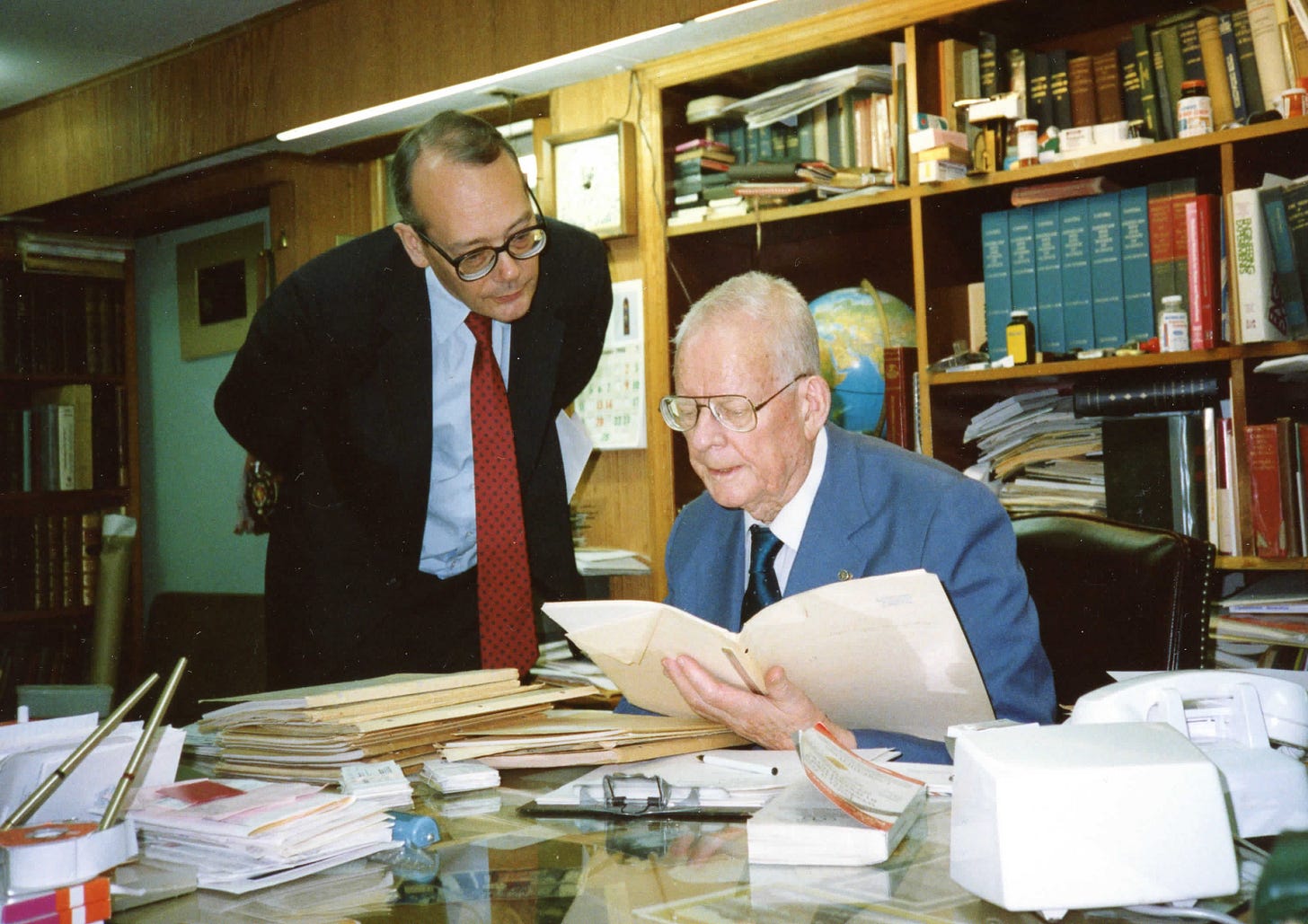W. Edwards Deming's 14 Points for Management
W. Edwards Deming working in his home office, late 1980s. Photo courtesy of The W. Edwards Deming Institute.
Many people are unaware of Dr. W. Edwards Deming, even though he is one of the most famous scholars in the field of management. As a leader and a businessman, he singlehandedly changed the way management was viewed by manufacturing and service firms around the globe. [1]
With this article we begin a series focused on summarizing the ideas Deming developed over his lifetime. In Part 1, we begin with perhaps his best-known concepts: the 14 Points for Management. Deming published the 14 Points in his second book, Out of the Crisis, published in 1986, as a general guide to improving the efficiency and effectiveness of an organization. [2]
Deming’s 14 Points for Management
Constancy of purpose. The first point is that leadership must define and promote a constancy of purpose, or aim, with the overall intent of continually improving the business in order to remain competitive, stay in business, increase investor value, and provide stable jobs.
Adopt a new philosophy for change. Organizations sometimes fall into a habit of fixed, tradition-based thinking. They must instead adopt a philosophy of tackling challenges, learning responsibilities, and promoting leadership of change. It is crucial that employees at all levels adopt this philosophy to make it felt throughout the entire firm.
Cease dependence on quality-by-inspection. Delivering quality through post-manufacturing inspection is dangerous—it does not lead to increased quality over the long term, and it is extremely wasteful. For this third point, Deming proposed eliminating the practice of quality-by-inspection and instead ensuring that quality is purposefully designed into the product during the manufacturing process.
End awarding business based solely on price. Deming supported the establishment of long-term relationships between a company and its vendors so that the two can collaborate over mutual improvements that result in higher-quality products. Price should not be the sole determiner of which vendor wins a contract.
Improve constantly. The management team should focus on continual improvement of the company’s processes, supply chains, and products. This improves quality and productivity while decreasing costs and waste over time.
Institute continual training at all levels. Deming observed that many companies, under the constant stress of meeting arbitrarily determined numerical targets, forego training in the interest of keeping workers “on the job.” Instead, the company must consider training a critical job function for all levels of experience or responsibility.
Institute leadership. Deming argued that the traditional supervision of employees, commonly referred to as “micro-management,” should be replaced with leadership that drives continual improvement of processes while supporting the needs of the employees and the system overall.
Eliminate fear. Many of Deming’s ideas connect back to the basic concept of eliminating fear. Only by eliminating fear can the company unlock intrinsic motivation and involve employees in improvement of the system.
Break down barriers. Deming observed that companies tend to create “silos,” within which groups of people are isolated from each other. He proposed breaking down barriers between management and employees, departments, employees, partners, vendors, and more, in order to create an overall organization that collaborates cohesively with everyone’s needs in mind.
Eliminate motivational devices. Companies should work on eliminating slogans, exhortations, posters, or targets as these do not improve the underlying system.
Eliminate targets and quotas for workers. Numerical targets for workers should be replaced with expectations for the system overall, then management must determine whether and by what method those expectations can be met. Removing numerical targets on workers reduces fear in the workplace and makes workers feel more supported.
Remove barriers for workers. Management should work to remove barriers such as unreliable machinery, broken tools, defective raw materials, overly complicated instructions, and fear-inducing policies. Removing such barriers allow workers to feel pride in workmanship and confidence in what they are doing instead of feeling like just another cog in the machine.
Focus on education and self-improvement. The next point is to institute a rigorous education and self-improvement program. Education drives innovation, which results in continual improvement of quality and productivity. Employees at all levels should aim to bring new knowledge into the organization.
Take action. The final point is that management must take steps to promote a culture of transformation to achieve the concepts above. It is not sufficient to simply ponder or consider them. Everyone in the company must take intentional steps and actively collaborate to improve its systems.
Will you use these theories in your organization?
Deming’s theories and management principles are critical to understanding how modern firms can achieve success and stability. They provide a lens through which business leaders can gain knowledge, and a toolkit they can apply for continual improvement. Adopting this philosophy of continual improvement results in a win-win-win for everyone: employees experience more joy in work, customers receive higher quality products, shareholders observe higher profits, and the organization survives and thrives over the long-term.
References
The Deming Institute. Deming The Man - The W. Edwards Deming Institute. Retrieved December 20, 2022.
Deming, W. Edwards. (1982) Out of the Crisis. Cambridge, MA: MIT Press.
Deming Center. W. Edwards Deming Center for Quality, Productivity, and Competitiveness. Retrieved December 20, 2022.
The Deming Institute. Dr. Deming’s 14 Points for Management - The W. Edwards Deming Institute. Retrieved December 20, 2022.





